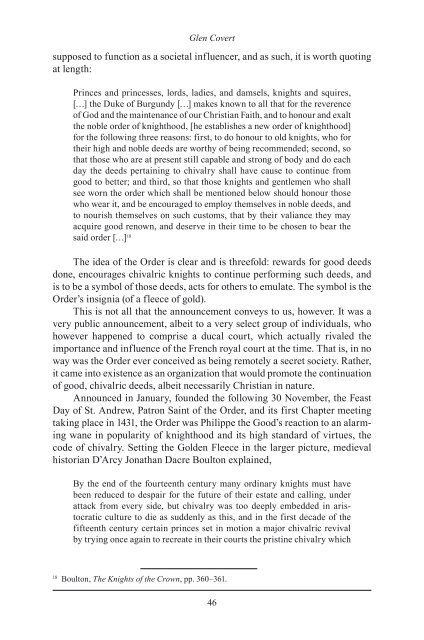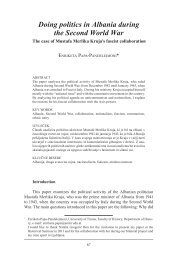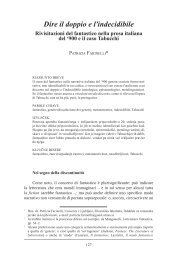The Habsburg Most Illustrious Order of the Golden Fleece: Its ...
The Habsburg Most Illustrious Order of the Golden Fleece: Its ...
The Habsburg Most Illustrious Order of the Golden Fleece: Its ...
Create successful ePaper yourself
Turn your PDF publications into a flip-book with our unique Google optimized e-Paper software.
Glen Covert<br />
supposed to function as a societal influencer, and as such, it is worth quoting<br />
at length:<br />
Princes and princesses, lords, ladies, and damsels, knights and squires,<br />
[…] <strong>the</strong> Duke <strong>of</strong> Burgundy […] makes known to all that for <strong>the</strong> reverence<br />
<strong>of</strong> God and <strong>the</strong> maintenance <strong>of</strong> our Christian Faith, and to honour and exalt<br />
<strong>the</strong> noble order <strong>of</strong> knighthood, [he establishes a new order <strong>of</strong> knighthood]<br />
for <strong>the</strong> following three reasons: first, to do honour to old knights, who for<br />
<strong>the</strong>ir high and noble deeds are worthy <strong>of</strong> being recommended; second, so<br />
that those who are at present still capable and strong <strong>of</strong> body and do each<br />
day <strong>the</strong> deeds pertaining to chivalry shall have cause to continue from<br />
good to better; and third, so that those knights and gentlemen who shall<br />
see worn <strong>the</strong> order which shall be mentioned below should honour those<br />
who wear it, and be encouraged to employ <strong>the</strong>mselves in noble deeds, and<br />
to nourish <strong>the</strong>mselves on such customs, that by <strong>the</strong>ir valiance <strong>the</strong>y may<br />
acquire good renown, and deserve in <strong>the</strong>ir time to be chosen to bear <strong>the</strong><br />
said order […] 18<br />
<strong>The</strong> idea <strong>of</strong> <strong>the</strong> <strong>Order</strong> is clear and is threefold: rewards for good deeds<br />
done, encourages chivalric knights to continue performing such deeds, and<br />
is to be a symbol <strong>of</strong> those deeds, acts for o<strong>the</strong>rs to emulate. <strong>The</strong> symbol is <strong>the</strong><br />
<strong>Order</strong>’s insignia (<strong>of</strong> a fleece <strong>of</strong> gold).<br />
This is not all that <strong>the</strong> announcement conveys to us, however. It was a<br />
very public announcement, albeit to a very select group <strong>of</strong> individuals, who<br />
however happened to comprise a ducal court, which actually rivaled <strong>the</strong><br />
importance and influence <strong>of</strong> <strong>the</strong> French royal court at <strong>the</strong> time. That is, in no<br />
way was <strong>the</strong> <strong>Order</strong> ever conceived as being remotely a secret society. Ra<strong>the</strong>r,<br />
it came into existence as an organization that would promote <strong>the</strong> continuation<br />
<strong>of</strong> good, chivalric deeds, albeit necessarily Christian in nature.<br />
Announced in January, founded <strong>the</strong> following 30 November, <strong>the</strong> Feast<br />
Day <strong>of</strong> St. Andrew, Patron Saint <strong>of</strong> <strong>the</strong> <strong>Order</strong>, and its first Chapter meeting<br />
taking place in 1431, <strong>the</strong> <strong>Order</strong> was Philippe <strong>the</strong> Good’s reaction to an alarming<br />
wane in popularity <strong>of</strong> knighthood and its high standard <strong>of</strong> virtues, <strong>the</strong><br />
code <strong>of</strong> chivalry. Setting <strong>the</strong> <strong>Golden</strong> <strong>Fleece</strong> in <strong>the</strong> larger picture, medieval<br />
historian D’Arcy Jonathan Dacre Boulton explained,<br />
By <strong>the</strong> end <strong>of</strong> <strong>the</strong> fourteenth century many ordinary knights must have<br />
been reduced to despair for <strong>the</strong> future <strong>of</strong> <strong>the</strong>ir estate and calling, under<br />
attack from every side, but chivalry was too deeply embedded in aristocratic<br />
culture to die as suddenly as this, and in <strong>the</strong> first decade <strong>of</strong> <strong>the</strong><br />
fifteenth century certain princes set in motion a major chivalric revival<br />
by trying once again to recreate in <strong>the</strong>ir courts <strong>the</strong> pristine chivalry which<br />
18 Boulton, <strong>The</strong> Knights <strong>of</strong> <strong>the</strong> Crown, pp. 360–361.<br />
46











